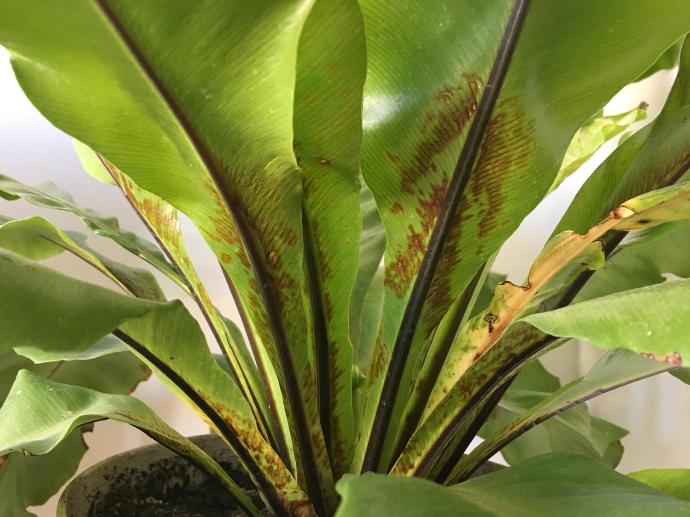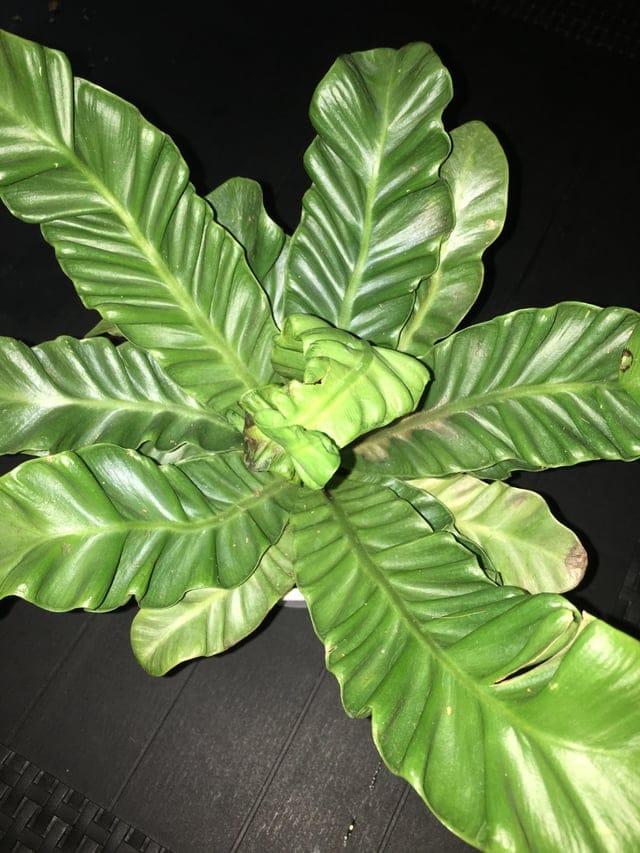Cobra Fern Plant
COBRA FERN, also known as Phlebodium aureum, is an indoor fern. Plant in well-draining soil and provide bright, indirect light. Keep the soil consistently moist and mist the leaves for humidity. Pruning helps remove old or damaged fronds.

Habit
Fern
Height
1-2 m
Growth
Slow
Soil
Well-drained organic
Shade
Low to medium Light
Moisture
Moist
Edible
No
Medicinal
Yes
Origin
Asia, Australia
Climatic Condition
Tropical, Humid
Temperature (°)
18-30°C
Humidity (%)
70-90%
Potting media
Peat, perlite
Fertilizers
Organic fertilizers
Watering
Regular misting
Plant Weight
500 g-2 kg
Flowering Time
Non-flowering
Soil Ph level
5.5 - 7.0
Water Ph level
5.5 - 7.0
Soil EC
1-2 dS/m
Yield Per Plant
Ornamental
NPK ratio
15:30:15
life Span
Perennial
Health Benefits
Anti-inflammatory, edible leaves
Suggested Grow Media or Potting Mix ?
50% peat moss, 30% pine bark, 20% perlite
Suggested Fertigation/Fertilizers
Fertilize every 4 weeks with a balanced, water-soluble fertilizer.
Common Diseases and Remedies
Leaf rot , Root rot , Bacterial blight
Yellowing , Browning and die back of leaves .
Good drainage , re-pot with fresh soil , remove rotten roots .
HEALTH BENEFITS
· Used in traditional medicine for wound healing and inflammation.
· May have antimicrobial and antioxidant properties.
· Some species are used for skin health and treating rashes.
What Is A cobra fern Tree?
Asplenium nidus, also known as Cobrasida, is a tropical fern native to Southeast Asia, often used as an ornamental plant. These plants are epiphytes in nature, meaning they grow on the surfaces of other plants. In rainforest homes, they grow high in the tree tops. These plants are called cobrasida because they have curled leaves that look like the hood of a cobra. These beautiful and rare plants can add uniqueness to your plant collection.

What Are The Different Types Of cobra fern Plants?
1. Asplenium nidus 'Crispy Wave
This variety is known for its wavy, wrinkled leaves that give the leaves a unique texture.
2. Asplenium nidus 'OSAKA'
The Osaka variety is known for its compact growth and short leaves compared to the standard bird's nest fern.
3. Asplenium nidus 'Victoria
This variety is characterized by its smaller size and more upright growth.
4. Asplenium nidus "Golden Bay"
The leaves of this variety have a characteristic golden yellow color, forming a striking contrast with the dark green color typical of this species.

How to care for Cobra fern Plants ?
1. Location
Swallow's nest fern is suitable for indoor cultivation and is therefore popular as a houseplant. It thrives in bright, indirect light, making it ideal for rooms with sunlight or partial shade. The indoor environment better controls temperature and humidity, creating conditions similar to the fern's natural tropical habitat. Swallow's Nest Ferns can be grown outdoors in tropical or subtropical climates where temperatures remain below freezing.
2. sunlight
Swallow's nest ferns prefer bright indirect light. Avoid direct sunlight as this can burn the delicate leaves. It can withstand poor lighting conditions, making it suitable for indoor spaces with filtered light.
3. Soil
Plant ferns in well-drained pots mixed with organic matter. A mixture of orchids or ferns is suitable. Make sure the soil stays evenly moist and not soggy.
4. Hydration
Keeps the soil evenly moist. Water when the soil surface feels a little dry. Bird's nest ferns prefer a constantly moist environment, so make sure the soil doesn't dry out completely.
5. Nutrition
General purpose fertilizer with NPK ratio of 10-10-10 or 14-14-14. This balanced ratio ensures that the fern receives sufficient nutrients for its overall growth and development.

6. Issues
Asplenium nidus, commonly known as the bird's nest fern, is a generally hardy and hardy plant. However, like any plant, certain problems can occur. A common problem is overwatering, which causes root rot. Bird's nest ferns prefer moist soil at all times, but can be damaged if left in standing water. To prevent this, ensure well-drained soil and wait until the top 1 inch of soil is dry before watering.
What are the Benefits of cobra fern Plants ?
Bird's nest fern is prized for its air purifying properties, as well as its low maintenance requirements, making it an excellent choice for both beginners and experienced plant enthusiasts. It does not require direct sunlight and can grow in shady environments, making it suitable for a variety of interiors.

FAQs About Growing cobra fern
1. How often should I water my Bird's Nest Fern?
Bird's Nest Ferns prefer consistently moist soil. Water when the top inch of the soil feels slightly dry to the touch, but avoid overwatering, as they are susceptible to root rot.
2. Can I grow a Bird's Nest Fern in low light conditions?
Yes, Bird's Nest Ferns can tolerate lower light conditions. They thrive in bright, indirect light but can adapt to shaded areas.
3. How do I increase humidity for my Bird's Nest Fern?
Increase humidity by misting the fronds regularly. Placing the pot on a tray filled with water and pebbles can also help maintain higher humidity levels.
4. Can Bird's Nest Ferns be grown outdoors?
Yes, Bird's Nest Ferns can be grown outdoors in tropical or subtropical climates. They prefer shaded or partially shaded locations.
5. Do Bird's Nest Ferns require frequent fertilization?
Bird's Nest Ferns are not heavy feeders. Fertilize with a balanced liquid fertilizer at half strength during the growing season (spring and summer), and reduce or eliminate fertilization in fall and winter




